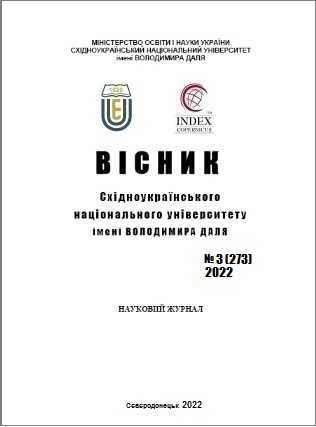Вплив на фотоемісійні властивості монокристалів GaAs адсорбованих атомів Ge
DOI:
https://doi.org/10.33216/1998-7927-2022-273-3-24-29Ключові слова:
фотоемісія, квантовий вихід, розподіл фотоелектронів за енергіями, робота виходу, загин зон, електронна спорідненість, напівпровідникиАнотація
Напівпровідникові з'єднання А3В5 у перспективі є найперспективнішими для подальшого докладного розгляду. У цьому відношенні арсенід галію є напівпровідниковим з'єднанням, утвореним елементами III і V груп періодичної системи – галієм Ga та миш'яком As. Арсенід галію та його поверхневі властивості привертають велику увагу дослідників у зв'язку з можливістю його широкого застосування у техніці мікро- та наноелектроніки. Незважаючи на численні дослідження поверхні напівпровідників, багато питань, пов'язаних з її властивостями та процесами на межі розділу двох фаз, залишаються недостатньо з'ясованими, особливо щодо впливу стану поверхні на енергетичний спектр електронів у кристалах. Інтерес до цих питань постійно зростає не лише з наукової точки зору, але й із практичної, у зв'язку з розвитком напівпровідникової мікро- та нанотехнологій. Розробка таких її розділів, як тонкошарова наноелектроніка та оптоелектроніка, пристрої з МДП-структурами та зарядовим зв'язком, холодні катоди та ефективні фотокатоди вимагають розуміння процесів у приповерхневому шарі напівпровідника як з вільною поверхнею, так і з цією вільною поверхнею при адсорбції інших речовин на неї. Це важливо і для з'ясування можливості зміни поверхневих та приповерхневих властивостей твердих тіл цілком певним чином. Арсенід галію є найближчим бінарним аналогом германію. Введенням відповідних домішок арсенід галію може бути отриманий з провідністю як n-типу, так і p-типу з різними концентраціями носіїв струму. Структура арсеніда галію належить до кристалографічного класу кубічної системи, як і германій. Арсенід галію і германій кристалізуються в структурі цинкової обманки. З огляду на сказане вище, цікаво провести вивчення фотоемісійним методом у надвисокому вакуумі вплив адсорбованих шарів германію на поверхневі властивості монокристалів арсеніду галію різного типу провідності. Також розглянуто питання впливу цих покриттів як на емісійні властивості монокристалів арсеніду галію, а й вплив цих адсорбованих атомів германію на енергетичну структуру в приповерхневій області монокристалів.
Посилання
1. Электронные явления на поверхности полупроводников / В.И. Ляшенко [та ін.]. Київ: Науко-ва думк, 1969. 358 с.
2. Киселев В.Ф. Поверхностные явления в полупровод-никах и диэлектриках. М.: Наука, 1971. 320 с.
3. Ржанов А.В. Электронные процессы на поверхности полупроводников. М.: Наука, 1973. 268 с.
4. Волькинштейн Ф.Ф. Физико-химия поверхности по-лупроводников. М.:Наука, 1980. 345 с.
5. J. Scheer, J. van Laar, The influence of cesium adsorption on surface Fermi level position in gallium frsenide. Surf/ Sci., 1969, 18. p 130-139.
6. G.Q. Gobely, F.G. Allen, Photoelektric Propertiec of Cleaved GaAs, GaSb, InAs and InSb Comparison with Si and Ge. Phys. Rev. 1965, 137. PA245-A249.
7. Кремков М.В. Корпускулярная низкоэнергетическая диагностика поверхности твердого тела. Ташкент: Изд-во «ФАН» Узб. ССР, 1986. 164 с.
8. James L.W., Mool J.L., Photoemissiya fdrom GaAs of p-type at adsorption of Cs and O. Phys. Rev. Lett.,1969, 183. p. 740-745.
9. Eden R.C., Mool J.L.,Spicer W.E., Photoemissiya proper-ties of p-type gallium arsenide in the adsorption of cesium and oxygen. Phys. Rev. Lett.,1969, 18. p. 597-600..
10. J. Scheer, J. van Laar, Effect of Cesium anmd Oxygen on the Thresh0ld of Photoemission from the Surface of Gal-lium Arsenide. Sol. St. Comm., 1965?3. p 189-194.
11. H. Sonnenberg, Photocathjodes of gallium arsenide with negative electron affinity. Appl. Phys. Lett., 1970, 16. P. 245-248.
12. Fiacherr T.E., Determination of Semiconductor Surface properties by means of photoekectric emission. Surface Science, 1969, 13/ p. 30-52.
13. Sommer A.H., Photoemitters with negative electron affini-ty. J. Appl. Phys., 1972, 42. p. 2158-2164.
14. Schage H., Nelson H., Kressel H., High efficiency of emission from GaAs photocathodes dsoped with Ge. Appl. Phys. Lett. 1971, 18. H. 121-126.
15. Кулышев А.М., Черникова И.Д., Черников Н.Г., Нанометрический корпускулярный фотоэлектронныйспектрометр. Вісник СНУ ім. В. Даля, Сєвєродонецьк, №5(222). 2015. С.40-45
16. Arsenjeva-Geil A.N., Chernikov N.G., Effect of Germa-nium coating on the Photoemission of Gallium Arsenide crystals. Sov. Phys. Solid Stat 1975, p 3388=-3390.
17. Влияние структурных изменнений на поверхности на энергетический спектр электронов в арсениде галлия./ Черников Н.Г.[и др.]. Вісник СНУ ім. В.Даля №122(154) ч. 2, Луганськ 2010. С.81-84
18. Кормилицина Е.В., Черникова И.Д., Фотоємиссионная спектроскопия из поверхности GaAs. Матеріали XVIIIміжнародної науково технічної конференції, м. Сєвєродонецьк 17-18 квітня 2015, ч.2. с. 81-84
19. Кулышев А.М., Черникова И.Д., Черников Н.Г., Влия-ние состояния поверхности полупроводников на работу фотодетекторов. Вісник СНУ ім. В.Даля №2(226) Сєвєродонецьк 2016. С.112-123
20. Bergstresser T.K., Rublof S.W., The effect of germanium impurities on the emission properties of p-type gallium ar-senide. Phys. Rev. Lett., 1973< 30. P. 794-799.

